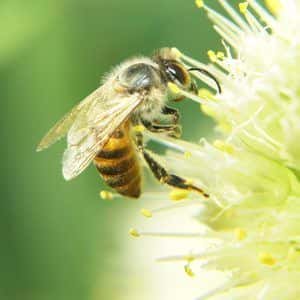
Most people have never heard of bee sting therapy. The idea that someone would voluntarily seek to be stung seems implausible. And yet apitherapy has a venerable history. We were fortunate enough to interview Charles Mraz on our radio show many decades ago. He was a beekeeper in Middlebury, Vermont and the country’s leading advocate for apitherapy. He explained to our listeners that honey bee venom helped ease the inflammation arthritis pain. Mr. Mraz died almost 20 years ago, but enthusiasm for bee sting therapy lives on.
Grandmothers and Bee Sting Therapy
Q. My grandmother taught me that bee stings would relieve arthritis pain for an extended time. Do you have any information regarding the relief of arthritis pain by bee stings?
A. Modern medicine doesn’t think much of bee sting therapy. It’s not the sort of thing students learn about in medical school. Departments of rheumatology and immunology do not consider apitherapy when patients with arthritis ask for help.
But bee sting therapy has a long history. There are reports that it was used in ancient Egypt and China. Hippocrates (460-370 BC) is purported to have written about bee stings for painful joints.
Dr. Philipp Terc was an Austrian physician. He wrote about bee venom therapy (apitherapy) in 1888 when he published “About a Peculiar Connection Between the Bee Stings and Rheumatism.”
Several medical doctors in this country used bee venom therapy to treat arthritis pain during the first part of the 20th century. Hospital pharmacies even stocked venom for injections.
In 1935, Dr. Bodog Beck wrote a book titled “Bee Venom Therapy.” It detailed the application of bee sting therapy to treat arthritis and other inflammatory conditions. Charlie Mraz wrote a foreword to Dr. Beck’s book in the 1981 edition (at The American Apitherapy Society Inc.)
“I first met Dr. Beck in 1935, soon after I became interested in bee venom therapy following a personal experience with a bad case of rheumatic fever. Once I had heard about him, I visited him at his office many times.
“During the 1930s, when I knew him, there was a great deal of attention paid to bee venom therapy in Europe, especially in Germany and Austria , as well as some interest in the U.S. At this time there was much interest in producing an injectable bee venom solution that could be administered with an injection needle rather than with a live bee. Some of the solutions produced at the time were “Apiven,” “Venapis,” “Lyovac,” and “Imminin.” Most of these solutions were not as effective as the live bee, and after giving them a trial Dr. Beck stopped using them.
“For many years Dr. Beck, like many doctors before and after him, tried to have bee venom therapy recognized by the medical profession, but without success. As with Dr. Anton Terc, of Marburg , Austria , the “father” of bee venom therapy over 100 years ago, they failed to create any interest in bee venom’s acceptance in medical practice.”
Stories from Readers:
Over 19 years ago we received this intriguing story from a reader of our syndicated newspaper column:
“While snoozing on the porch I was stung on the finger of my left hand by a tiny bee. The result: intense pain for a week, and after that a great reduction of arthritis in my left arm.
“How can I get stung on my other arm? Are there physicians who specialize in bee stings or do I need to find a friendly bee keeper?”
A. As strange as it may sound, bee venom therapy for arthritis was used by a few doctors in this country between World War I and World War II. Hospital pharmacies stocked an injectable solution of mixed venoms. This therapy fell out of favor for lack of scientific proof.
A nurse shared this thought about bee sting therapy for arthritis:
“I’m a nurse in a rural hospital. Some of the mountain folk I care for tell me that a bee sting every two years or so will significantly decrease arthritis pain and inflammation. They attribute this remedy to the Chinese who came to this area a hundred years ago to work on the railroads and in the logging industry.”
A reader related a story about shingles pain (post herpetic neuralgia) and accidental bee sting “therapy.”
“My dad has suffered with pain from shingles for almost 2 years. Yesterday, during a nap on the deck, he got stung on the toe by a bee. Even though that was painful, he’s feeling no shingles pain! Did you ever heard of such a thing? He’s perplexed but elated, for however long the freedom lasts.”
We actually interviewed a physician, Andrew Kochan, MD, who uses bee stings to treat post herpetic neuralgia (shingles pain). He is past president of the American Apitherapy Society. Here is a link to that show. You can listen to the streaming audio, purchase a CD or download the mp3 file.
Show 1032: How to Use Products of the Bee Hive for Healing
New Research into Bee Venom:
A recent study used bee venom to treat experimentally-induced arthritis in rats (Toxicon, Apr. 1, 2019). The scientists found that honeybee venom has a range of anti-inflammatory properties. It may be an effective option for reducing inflammation in rheumatoid arthritis. Dose is critical, however, and low doses appear to be more effective.
Words of Caution About Bee Sting Therapy!
Some people are highly allergic to honeybee venom and may die from anaphylactic shock if they are stung. Skilled practitioners must be prepared for such emergencies. Epinephrine is essential and rapid access to an emergency department is crucial. Do NOT try bee sting therapy at home on your own!
You can learn more about bee venom therapy and other options for treating joint pain in our eGuide to Alternatives for Arthritis. Here is a link.
Share your own story about treating arthritis pain in the comment section below.

